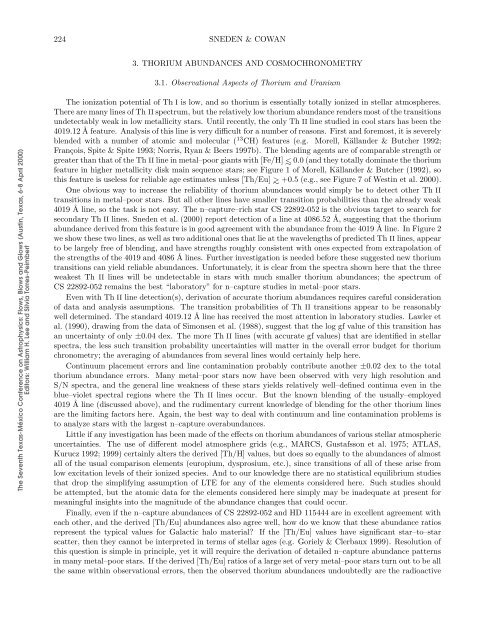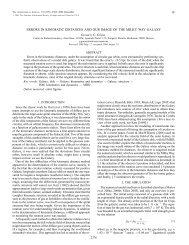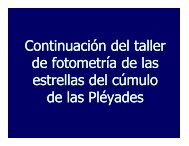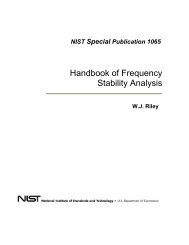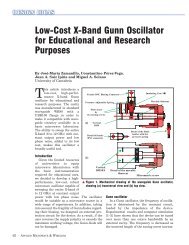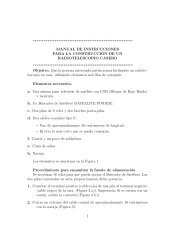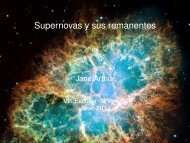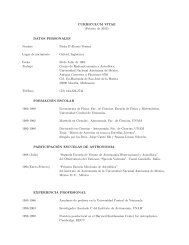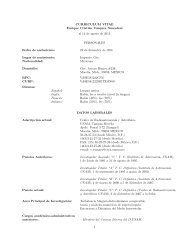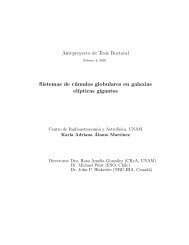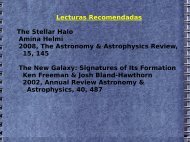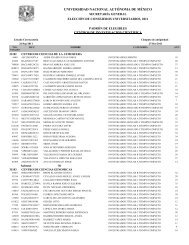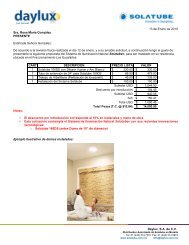the age of the galaxy from thorium cosmochronometry
the age of the galaxy from thorium cosmochronometry
the age of the galaxy from thorium cosmochronometry
- No tags were found...
You also want an ePaper? Increase the reach of your titles
YUMPU automatically turns print PDFs into web optimized ePapers that Google loves.
224 SNEDEN & COWAN3. THORIUM ABUNDANCES AND COSMOCHRONOMETRY3.1. Observational Aspects <strong>of</strong> Thorium and UraniumThe Seventh Texas-México Conference on Astrophysics: Flows, Blows and Glows (Austin, Texas, 6-8 April 2000)Editors: William H. Lee and Silvia Torres-PeimbertThe ionization potential <strong>of</strong> Th I is low, and so <strong>thorium</strong> is essentially totally ionized in stellar atmospheres.There are many lines <strong>of</strong> Th II spectrum, but <strong>the</strong> relatively low <strong>thorium</strong> abundance renders most <strong>of</strong> <strong>the</strong> transitionsundetectably weak in low metallicity stars. Until recently, <strong>the</strong> only Th II line studied in cool stars has been <strong>the</strong>4019.12 Å feature. Analysis <strong>of</strong> this line is very difficult for a number <strong>of</strong> reasons. First and foremost, it is severelyblended with a number <strong>of</strong> atomic and molecular ( 13 CH) features (e.g. Morell, Källander & Butcher 1992;François, Spite & Spite 1993; Norris, Ryan & Beers 1997b). The blending <strong>age</strong>nts are <strong>of</strong> comparable strength orgreater than that <strong>of</strong> <strong>the</strong> Th II line in metal–poor giants with [Fe/H] ∼ < 0.0 (and <strong>the</strong>y totally dominate <strong>the</strong> <strong>thorium</strong>feature in higher metallicity disk main sequence stars; see Figure 1 <strong>of</strong> Morell, Källander & Butcher (1992), sothis feature is useless for reliable <strong>age</strong> estimates unless [Th/Eu] ∼ > +0.5 (e.g., see Figure 7 <strong>of</strong> Westin et al. 2000).One obvious way to increase <strong>the</strong> reliability <strong>of</strong> <strong>thorium</strong> abundances would simply be to detect o<strong>the</strong>r Th IItransitions in metal–poor stars. But all o<strong>the</strong>r lines have smaller transition probabilities than <strong>the</strong> already weak4019 Å line, so <strong>the</strong> task is not easy. The n–capture–rich star CS 22892-052 is <strong>the</strong> obvious target to search forsecondary Th II lines. Sneden et al. (2000) report detection <strong>of</strong> a line at 4086.52 Å, suggesting that <strong>the</strong> <strong>thorium</strong>abundance derived <strong>from</strong> this feature is in good agreement with <strong>the</strong> abundance <strong>from</strong> <strong>the</strong> 4019 Å line. In Figure 2we show <strong>the</strong>se two lines, as well as two additional ones that lie at <strong>the</strong> wavelengths <strong>of</strong> predicted Th II lines, appearto be largely free <strong>of</strong> blending, and have strengths roughly consistent with ones expected <strong>from</strong> extrapolation <strong>of</strong><strong>the</strong> strengths <strong>of</strong> <strong>the</strong> 4019 and 4086 Å lines. Fur<strong>the</strong>r investigation is needed before <strong>the</strong>se suggested new <strong>thorium</strong>transitions can yield reliable abundances. Unfortunately, it is clear <strong>from</strong> <strong>the</strong> spectra shown here that <strong>the</strong> threeweakest Th II lines will be undetectable in stars with much smaller <strong>thorium</strong> abundances; <strong>the</strong> spectrum <strong>of</strong>CS 22892-052 remains <strong>the</strong> best “laboratory” for n–capture studies in metal–poor stars.Even with Th II line detection(s), derivation <strong>of</strong> accurate <strong>thorium</strong> abundances requires careful consideration<strong>of</strong> data and analysis assumptions. The transition probabilities <strong>of</strong> Th II transitions appear to be reasonablywell determined. The standard 4019.12 Å line has received <strong>the</strong> most attention in laboratory studies. Lawler etal. (1990), drawing <strong>from</strong> <strong>the</strong> data <strong>of</strong> Simonsen et al. (1988), suggest that <strong>the</strong> log gf value <strong>of</strong> this transition hasan uncertainty <strong>of</strong> only ±0.04 dex. The more Th II lines (with accurate gf values) that are identified in stellarspectra, <strong>the</strong> less such transition probability uncertainties will matter in <strong>the</strong> overall error budget for <strong>thorium</strong>chronometry; <strong>the</strong> averaging <strong>of</strong> abundances <strong>from</strong> several lines would certainly help here.Continuum placement errors and line contamination probably contribute ano<strong>the</strong>r ±0.02 dex to <strong>the</strong> total<strong>thorium</strong> abundance errors. Many metal–poor stars now have been observed with very high resolution andS/N spectra, and <strong>the</strong> general line weakness <strong>of</strong> <strong>the</strong>se stars yields relatively well–defined continua even in <strong>the</strong>blue–violet spectral regions where <strong>the</strong> Th II lines occur. But <strong>the</strong> known blending <strong>of</strong> <strong>the</strong> usually–employed4019 Å line (discussed above), and <strong>the</strong> rudimentary current knowledge <strong>of</strong> blending for <strong>the</strong> o<strong>the</strong>r <strong>thorium</strong> linesare <strong>the</strong> limiting factors here. Again, <strong>the</strong> best way to deal with continuum and line contamination problems isto analyze stars with <strong>the</strong> largest n–capture overabundances.Little if any investigation has been made <strong>of</strong> <strong>the</strong> effects on <strong>thorium</strong> abundances <strong>of</strong> various stellar atmosphericuncertainties. The use <strong>of</strong> different model atmosphere grids (e.g., MARCS, Gustafsson et al. 1975; ATLAS,Kurucz 1992; 1999) certainly alters <strong>the</strong> derived [Th/H] values, but does so equally to <strong>the</strong> abundances <strong>of</strong> almostall <strong>of</strong> <strong>the</strong> usual comparison elements (europium, dysprosium, etc.), since transitions <strong>of</strong> all <strong>of</strong> <strong>the</strong>se arise <strong>from</strong>low excitation levels <strong>of</strong> <strong>the</strong>ir ionized species. And to our knowledge <strong>the</strong>re are no statistical equilibrium studiesthat drop <strong>the</strong> simplifying assumption <strong>of</strong> LTE for any <strong>of</strong> <strong>the</strong> elements considered here. Such studies shouldbe attempted, but <strong>the</strong> atomic data for <strong>the</strong> elements considered here simply may be inadequate at present formeaningful insights into <strong>the</strong> magnitude <strong>of</strong> <strong>the</strong> abundance changes that could occur.Finally, even if <strong>the</strong> n–capture abundances <strong>of</strong> CS 22892-052 and HD 115444 are in excellent agreement wi<strong>the</strong>ach o<strong>the</strong>r, and <strong>the</strong> derived [Th/Eu] abundances also agree well, how do we know that <strong>the</strong>se abundance ratiosrepresent <strong>the</strong> typical values for Galactic halo material? If <strong>the</strong> [Th/Eu] values have significant star–to–starscatter, <strong>the</strong>n <strong>the</strong>y cannot be interpreted in terms <strong>of</strong> stellar <strong>age</strong>s (e.g. Goriely & Clerbaux 1999). Resolution <strong>of</strong>this question is simple in principle, yet it will require <strong>the</strong> derivation <strong>of</strong> detailed n–capture abundance patternsin many metal–poor stars. If <strong>the</strong> derived [Th/Eu] ratios <strong>of</strong> a large set <strong>of</strong> very metal–poor stars turn out to be all<strong>the</strong> same within observational errors, <strong>the</strong>n <strong>the</strong> observed <strong>thorium</strong> abundances undoubtedly are <strong>the</strong> radioactive


